Bharatanatyam the Indian Dance
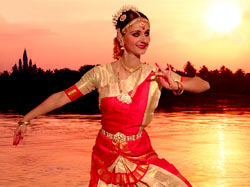 One
of the richest and oldest classical dance forms of the world, this art form
derives its name from three vital aspects that constitute the dance. 'Bha'-
comes from 'bhava' (emotions) around which a particular dance composition is
knitted. 'Ra'- comes from 'raga' (melody) on which the dance is floated. 'Ta'-
comes from 'tala' (rhythm) which forms the bedrock of the dance composition.The
dance form is characterized by angular and linear body movements & the subtle
use of facial expressions. It is an esthetic visual experience that transforms
the transient into the absolute.
One
of the richest and oldest classical dance forms of the world, this art form
derives its name from three vital aspects that constitute the dance. 'Bha'-
comes from 'bhava' (emotions) around which a particular dance composition is
knitted. 'Ra'- comes from 'raga' (melody) on which the dance is floated. 'Ta'-
comes from 'tala' (rhythm) which forms the bedrock of the dance composition.The
dance form is characterized by angular and linear body movements & the subtle
use of facial expressions. It is an esthetic visual experience that transforms
the transient into the absolute.
My review
Every human being has a natural need to experience in his life some kind of beauty, and art is therefore part and parcel of a civilized society.
Krsna says in Bhagavad-gita (9.34): man-mana bhava mad-bhakto, mad-yaji mam namaskuru, mam evaisyasi yuktaivam, atmanam mat-parayanah. "Always think of me, become My devotee, pay obeisances to Me and worship Me. Thus fully absorbed in Me you will certainly come to Me."
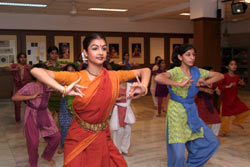 In the spirit of this verse Indian artists in the ancient times when
people from all levels of the society attempted for spiritual progress
were able to be constantly absorbed in Krishna consciousness by
engaging their talents in glorifying Krishna, depicting His pastimes
and other spiritual topics. Vedas inform us that Krishna, the Supreme
Personality of Godhead, is the cause of all causes including fine arts
existing from time immemorial. The original artistic branches are
described in the sastras (sacred scriptures) and one of them is
Natya-sastra. It describes theatre, music and mainly the dance and
several classical Indian dance forms have evolved from it. Bharata
Natyam dance is the oldest and
closest to the tradition of Natya-sastra.
In the spirit of this verse Indian artists in the ancient times when
people from all levels of the society attempted for spiritual progress
were able to be constantly absorbed in Krishna consciousness by
engaging their talents in glorifying Krishna, depicting His pastimes
and other spiritual topics. Vedas inform us that Krishna, the Supreme
Personality of Godhead, is the cause of all causes including fine arts
existing from time immemorial. The original artistic branches are
described in the sastras (sacred scriptures) and one of them is
Natya-sastra. It describes theatre, music and mainly the dance and
several classical Indian dance forms have evolved from it. Bharata
Natyam dance is the oldest and
closest to the tradition of Natya-sastra.
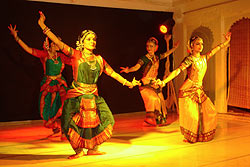 Despite its ancient origin, Bharata Natyam is the most popular dance
form in today's India and is a part of temple ceremonies up till now.
Due to its high aesthetics and exceptional expressional means Bharata
natyam got many well-wishers and dancers all around the world, mainly
in USA, Canada and France in last twenty years. Unfortunately, in our
country this dance form is not yet well known.
Despite its ancient origin, Bharata Natyam is the most popular dance
form in today's India and is a part of temple ceremonies up till now.
Due to its high aesthetics and exceptional expressional means Bharata
natyam got many well-wishers and dancers all around the world, mainly
in USA, Canada and France in last twenty years. Unfortunately, in our
country this dance form is not yet well known.
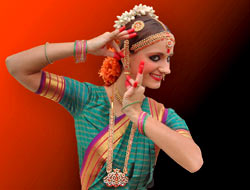 Non-professional audience consider Bharata Natyam to be something
between dance, pantomime and theatre, and actually they are right.
There are two styles - nrta and natya. Nrta is a very dynamic abstract
form consisting of sets of complicated dance steps appended by mudras (hand and palm gestures). Natya describes stories from the Vedas,
depicts spiritual topics or interprets classical devotional songs
(bhajans). As her expressional means the dancer uses mainly different
mudras and face mimics. In this way the whole performance becomes a
deep experience.
Non-professional audience consider Bharata Natyam to be something
between dance, pantomime and theatre, and actually they are right.
There are two styles - nrta and natya. Nrta is a very dynamic abstract
form consisting of sets of complicated dance steps appended by mudras (hand and palm gestures). Natya describes stories from the Vedas,
depicts spiritual topics or interprets classical devotional songs
(bhajans). As her expressional means the dancer uses mainly different
mudras and face mimics. In this way the whole performance becomes a
deep experience.
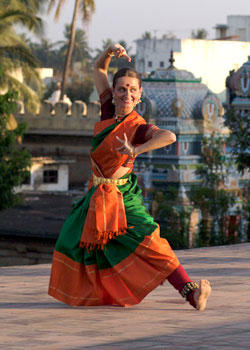 There is a common idea amongst the people that for a human being to be
fully dedicated to spiritual life, he has to give up his hobby.
However, the system of bhakti yoga is so perfect that it recommends to
everybody to engage everything including his skills in the process of
self-realization.
There is a common idea amongst the people that for a human being to be
fully dedicated to spiritual life, he has to give up his hobby.
However, the system of bhakti yoga is so perfect that it recommends to
everybody to engage everything including his skills in the process of
self-realization.
As for myself, since my childhood I've been always fascinated by dance itself, and as I grew up, I tried to to express my thoughts, ideas and my view on the world by it. When I was fifteen I began to fully devote myself to bhakti-yoga, and I had the first opportunity to see a performance of an excellent French dancer who had studied Bharata Natyam for few years in India. Later I started to study the basics of the dance from Mr. Jiri Cumpelik in Prague. After that I went to India where I started to study under the guidance of the worldwide reputable expert Mrs.Yamuna Krishnan who is my dance Guru till now.
Considering that Bharata Natyam is purely spiritual activity, there is practically no moment in which one would not feel the need to develop further. Although a great stress is given on a technical performance and there is a strict grammar, the essence is the inner mood of the dancer and without it the whole show looses its meaning. Therefore, the longer I've been devoting myself to the spiritual life, the deeper I'm able to go into the mysteries of Bharata Natyam and, on the other hand, the more I try to progress in dance, the more I feel its benefit for my own spiritual life.
Rasabihari Devi Dasi